Subscribe to our newsletter
JOIN PRE’S MAILING LIST – If you’d like to receive updates regarding the latest PRE news, please use the form below.
Moving Forward on Racial Justice Philanthropy is the fifth volume of the Critical Issues Forum series, which aims to deepen the discourse around important progressive racial justice issues within philanthropy. In this journal we share essays and interviews with activists and funders, tackling a range of current issues, challenges and opportunities as they reflect on the trajectory of racial justice and philanthropy over the past two decades.

Lori Villarosa is the executive director and founder of the Philanthropic Initiative for Racial Equity (PRE).
“Have you seen any progress?” This is a question most of us are asked in our work toward social change. It is asked of ourselves, asked by our funders or boards or others. And when we focus that question on racial justice, a source of ongoing discourse where one’s answer can signify our level of awareness and be taken as a testament of our own righteousness, it’s an even more weighted question.
If we say there is no progress, are we denying huge strides? Are we invalidating reasons to keep trying? On the other hand, if we say there has been great progress, do we risk a self-congratulatory invitation to complacency? Full Text
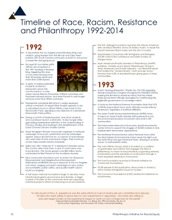 By Larry Raphael Salomon, Julie Quiroz, Maggie Potapchuk and Lori Villarosa.
By Larry Raphael Salomon, Julie Quiroz, Maggie Potapchuk and Lori Villarosa.
This historical timeline attempts to capture, in one place, many significant moments, events, controversies and victories that have defined the racial landscape since the turbulent days following the LAPD/Rodney King beating verdict over two decades ago. When communities in Los Angeles rebelled, “race riots” exploded the commonly held myth that our nation had progressed from the explicitly unjust conditions that had defined earlier generations. And in the decades since, the history chronicled in this timeline belies the notion that the U.S. is a “post-racial” society.
For funders seeking to understand and provide resources in support of racial justice work, this timeline also includes some of the key events in philanthropy that were shaped by the incidents, policies and cultural manifestations of race and racism during these years. Full Text Daniel Martinez HoSang is an associate professor of Ethnic Studies and Political Science at the University of Oregon.
Daniel Martinez HoSang is an associate professor of Ethnic Studies and Political Science at the University of Oregon.
In the mid-1990s, public policies to promote racial justice faced a new round of attacks. In California, the bluest of blue states, voters approved ballot measures eliminating public affirmative action and bilingual education programs – ending public education and health care for many immigrants, and expanding the state’s already massive and deeply racialized prison system. Affirmative action programs soon fell in six other states, and the rise of “colorblind” rhetoric among liberals and conservatives alike seemed to signal a decisive transformation in public attitudes about civil rights and racial justice.
Full Text Rick Cohen is the national correspondent of the Nonprofit Quarterly magazine, (NPQ).
Rick Cohen is the national correspondent of the Nonprofit Quarterly magazine, (NPQ).
Editors’ Note: This retrospective look at the past two decades of philanthropy’s approaches to race was primarily based on interviews with 21 racial justice and equity leaders in the field. This article shares their stories, experiences and reflections on how the sector has changed and evolved in addressing race over the past 20 years and into the present. In some cases, they found themselves responding to factors outside of their institutions – incidents and dynamics in which nuances of race beyond the easily observable manifestations of racial animus propelled them to sharpen or deepen their understandings. In others, the impetus came internally, from the intersection of the quality and composition of foundation leadership with the foundations’ social justice missions. This led to grantmaking that wasn’t simply “designated” for specific racial or ethnic groups, but aimed at addressing and rectifying racial disparities that result from complex dynamics.
We offer this mix of reflections recognizing that there was progress made in earlier stages of the field that can easily be forgotten and yet still holds lessons – in spite of being too soon lost in the collective discourse, or buried in reports on foundation shelves. We know it is not comprehensive, and many key moments and actors are still missing, but we believe it helps share a slice of the path of this work. Full Text
 Julie Quiroz is a senior fellow at the Movement Strategy Center.
Julie Quiroz is a senior fellow at the Movement Strategy Center.
Fifty years after the major victories of the civil rights movement, racial justice activists share a sense of bitter dismay at what Judith Browne Dianis, director of Advancement Project, calls a “new normal” of racial injustice that is actually painfully old. “Like the civil rights placard ‘I am a man,”” says Taj James, pointing to the campaign by San Francisco group POWER following George Zimmerman’s acquittal, “we needed to declare again that Black lives matter.” According to James, who began his racial justice work as a Black youth organizer two decades ago and now heads the Movement Strategy Center, “It can feel like we walked back in time to a moment we never left. Full Text

 Interviews and case studies of the foundations were done by Lisa McGill, the principal of LM Strategies Consulting and Maggie Potapchuk, the principal of MP Associates.
As structural racism analysis and concepts have evolved over the past 20 years, forward-thinking foundations have increasingly taken intentional steps to address the root causes of racism and disparities through grantmaking.
This retrospective publication provides PRE with an opportunity to highlight some of the principles, lessons and challenges of this work as experienced by different types of foundations. To select the subjects of the four case studies in this volume, PRE sought out institutions that have engaged in intentional practices to strengthen racial justice grantmaking. We deliberately selected a diverse group of private foundations that are at different stages of integrating structural racism analysis in their work, so that both small and large funders could relate and learn from their experience.
We are extremely grateful that Woods Fund Chicago, The Z. Smith Reynolds Foundation, The California Endowment and the Akonadi Foundation all generously agreed to invest significant time in interviews and share internal material with us. Full Text
Interviews and case studies of the foundations were done by Lisa McGill, the principal of LM Strategies Consulting and Maggie Potapchuk, the principal of MP Associates.
As structural racism analysis and concepts have evolved over the past 20 years, forward-thinking foundations have increasingly taken intentional steps to address the root causes of racism and disparities through grantmaking.
This retrospective publication provides PRE with an opportunity to highlight some of the principles, lessons and challenges of this work as experienced by different types of foundations. To select the subjects of the four case studies in this volume, PRE sought out institutions that have engaged in intentional practices to strengthen racial justice grantmaking. We deliberately selected a diverse group of private foundations that are at different stages of integrating structural racism analysis in their work, so that both small and large funders could relate and learn from their experience.
We are extremely grateful that Woods Fund Chicago, The Z. Smith Reynolds Foundation, The California Endowment and the Akonadi Foundation all generously agreed to invest significant time in interviews and share internal material with us. Full Text Malkia Amala Cyril is the founder and executive director of the Center for Media Justice.
Malkia Amala Cyril is the founder and executive director of the Center for Media Justice.
This essay examines the centrality of strategies for media rights, access and representation as part of a comprehensive strategy for racial equity; and the role of philanthropy in ensuring the racial justice leadership to transform structural racism in the media. The successes of media justice movement-building are highlighted as a targeted approach to resourcing racial equity leadership within and beyond fights for progressive policy reform. Full Text
 Kalpana Krishnamurthy is the policy director at Forward Together.
Kalpana Krishnamurthy is the policy director at Forward Together.
Intersectionality is a term that comes up a lot in social justice work. It comes up when community groups are trying to describe how policies affect multiple people’s identities. It comes up when organizers are trying to push back on messaging that tries to simplify a policy fight to one aspect. It comes up when advocates are describing their political analysis. And it comes up in questions: What exactly is intersectionality? And why is it important for funders to understand it?
For feminists and LGBTQ people of color, having a theoretical framework like intersectionality to analyze how oppression is simultaneous and compounding has been key. This essay discusses the evolution of social change approaches that simultaneously address gender and race, or sexuality and race, and incorporates analysis of funding trends with insights from people of color who work on these issues in philanthropy. It also provides examples of how intersectional efforts can lead to stronger base-building and to policy victories over time, and recommendations to funders. Full TextMobilizing Community Power to Address Structural Racism is the fourth volume of Critical Issues Forum series. In this journal we share essays from a number of community activists, as well as interviews with activists and funders, tackling a range of current issues, challenges and opportunities as they strive to strengthen approaches to engage communities in a movement toward a truly multiracial democracy.
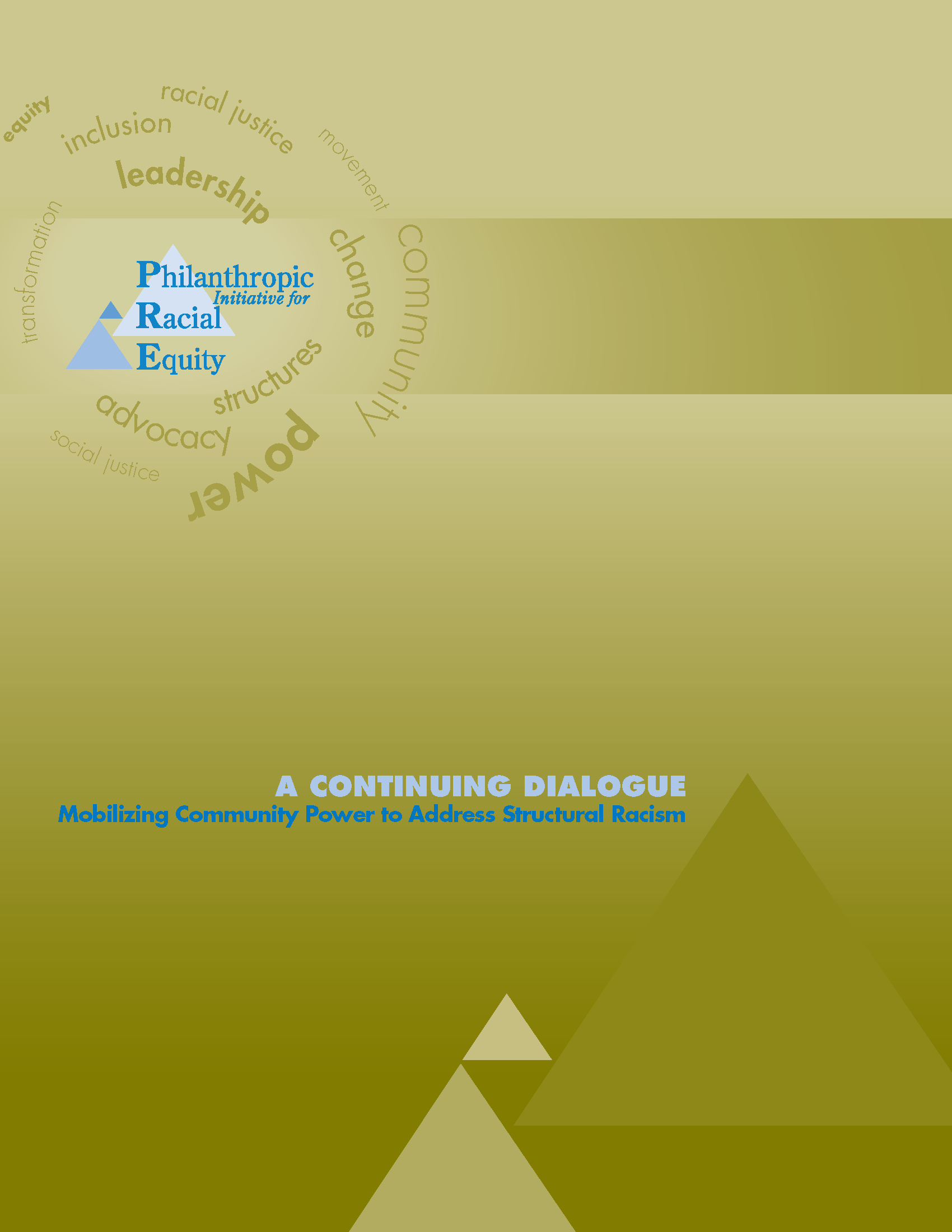
Mobilizing Community Power to Address Structural Racism is the fourth volume of the Critical Issues Forum series, which aims to deepen the discourse around important progressive racial justice issues within philanthropy. In this journal we share essays from a number of community activists, as well as interviews with activists and funders, tackling a range of current issues, challenges and opportunities as they strive to strengthen approaches to engage communities in a movement toward a truly multiracial democracy.
In December of 2011 PRE embarked on a project to explore the intersections of work on structural racism, community organizing and civic participation, raising key opportunities, challenges and questions for peers and funders to consider further. The effort began with, a daylong discussion with some leading community organizers and activists working on these issues at national and local levels, and was followed by discussions of funders, as well as among additional activists and organizers.
This publication shares the views of several of these thought leaders, as they synthesize the ways that supports are needed to strengthen the integration of these approaches with a structural racism analysis to improve outcomes for all through community organizing.
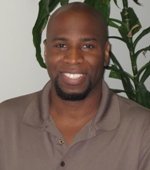 Nat Chioke Williams is the executive director of the Hill-Snowdon Foundation, a national family foundation.
Nat Chioke Williams is the executive director of the Hill-Snowdon Foundation, a national family foundation.
Over the past decade, the number of program officers, foundations and resources focused on social justice philanthropy has grown. As the social justice philanthropic field has expanded, it has tried to figure out how to effectively help secure a society that is just and fair. Some of us focus on building the social justice infrastructure, others on particular issues or constituencies, and still others on strategies like organizing or civic engagement. However, there is an overarching belief that we need to dramatically increase the scope and scale of social justice policy campaigns and victories if we are to achieve that just and fair society. The aftermath of some imperfect, but nonetheless big, progressive wins in recent years, and the ensuing backlash, has caused some of us to ask more fundamental questions. Are we really getting to the root causes of social injustice by focusing primarily on policy and/or electoral change? How do we better engage the hearts and minds of the public in the quest for real and lasting change?
 Lori Villarosa is the executive director and founder of the Philanthropic Initiative for Racial Equity (PRE).
Lori Villarosa is the executive director and founder of the Philanthropic Initiative for Racial Equity (PRE).
Projections of demographic shifts in the United States are clear: it is a matter of years before the majority of the population is composed of people of color. Yet cautionary comments remind us that “demographics are not destiny.” We have only to look around the world today to see that deep structural and racial inequalities can co-exist with varied population demographics. It will take intentionality, creativity, strategic thinking and resources to build a deep, sustainable and informed movement adequate to achieving a more egalitarian, multiracial democracy.
 Julie Quiroz is a senior fellow at the Movement Strategy Center.
Julie Quiroz is a senior fellow at the Movement Strategy Center.
Years of fighting racism have taught us many lessons, perhaps the greatest of which is the recognition that we have to be clear about the type of racism we intend to confront. If we take a narrow view of racism as a set of stereotypes or personal beliefs, then educational efforts aimed at individuals have some impact. But taking on structural racism requires entirely different approaches. As scholar Eduardo Bonilla-Silva asserts, “Social systems and their supports must be ‘shaken’ if fundamental transformations are to take place.” In order to shake such systems and structures, we would do well to keep in mind some important lessons – past and present – from the work of racial justice organizing.

Terry Keleher directs the Racial Justice Leadership Action Network at the Applied Research Center
In a society highly organized around racial inequality, we need to strengthen and support social change models that hold the most promise for transformative results. Grassroots models – community organizing, civic engagement and social justice movement building – are well suited for advancing racial justice because they emphasize empowering the disadvantaged, uniting different communities, challenging prevailing patterns of power, and striving for systemic change. To rise to their potential, these approaches must adopt new equity frameworks and practices that more directly, systematically and strategically challenge structural racism.
 DeAngelo Bester is the founder and executive director of the Workers Center for Racial Justice (WCRJ) in Chicago, IL.
DeAngelo Bester is the founder and executive director of the Workers Center for Racial Justice (WCRJ) in Chicago, IL.
 Valery Jean is the executive director of Families United for Racial & Economic Equality (FUREE), in Brooklyn, NY.
Valery Jean is the executive director of Families United for Racial & Economic Equality (FUREE), in Brooklyn, NY.
The majority of people born this year in the United States were children of color. Some progressives believe that this ongoing demographic transformation will disrupt the structural racism that persists in our nation. Evidence suggests that this view is mistaken. We need only look to the minority-majority state of California to see that racialized structures persist and democratic processes remain unreformed. Others in the progressive movement suggest that setting aside the issue of race and focusing on distributive justice can lead to racial and economic equity. This view is also mistaken. Consider how durable racialized structures, such as school and housing segregation, limit the ability of people of color to graduate, enter the workforce, and remain outside a disparately impactful penal system.
 Mari Ryono is the director of of development and evaluation of Mobilize the Immigrant Vote.
Mari Ryono is the director of of development and evaluation of Mobilize the Immigrant Vote.
 Angelica Salas is the executive director of The Coalition of Humane Rights of Los Angeles.
Angelica Salas is the executive director of The Coalition of Humane Rights of Los Angeles.
 Aparna Shah is the executive director of Mobilize the Immigrant Vote.
Aparna Shah is the executive director of Mobilize the Immigrant Vote.
In November 2010, the power of the emerging immigrant electorate became evident. Latinos in particular were credited with “saving the West” for Democrats by helping defeat anti-immigrant candidates and delivering victories to California Democrats such as Governor Jerry Brown and Attorney General Kamala Harris. In 2011, immigrant rights activists and voters helped defeat Arizona State Senator Russell Pearce, the architect of the notorious anti-immigrant SB 1070. “The Latino vote is now seen as a game changer in this country,” said Arturo Carmona, executive director of Presente.org. “Yet there is much work ahead to realize the promise. Collaborating with other communities of color to achieve power equity, justice and a more equitable economy is not only our responsibility as Latinos but required for our collective progress.
The 2010 U.S. Census underscores the growth of Latino, Asian and other immigrant populations in the United States. Currently, Asians represent nearly 6 percent of the total U.S. population, while Latinos remain the nation’s largest “minority” group at nearly 17 percent. According to Census Bureau projections, by the year 2050, the population of Asians in the U.S. is expected to triple to over 33 million. Latinos are expected to increase their numbers to over 100 million or, roughly speaking, 1 out of every 4 Americans. There are more than eight million immigrants with permanent legal residence who are eligible to become citizens in the United States. Full Text
The far right is putting up a tsunami of resistance in its attempt to reverse gains made by people of color over the past 50 years. We must fortify and anchor now so that we may move forward after the tide has washed over us. We are presenting this case study as an example of one way that grassroots organizations are maintaining and advancing a position reflective of those gains, while making an important contribution to movement building in the face of the challenge.
Racial justice is a fundamental part of any path to social justice in the United States, and it will only be attained to the degree that structural racism and accompanying social inequality are addressed. People of color will become a collective new majority of the U.S. population by 2040. This demographic shift provides a basis to transform the country, provided that we can become capable of the kind of struggle that is necessary for transformation. In order to overcome historic structures of domination and control, organized communities of color and low-wealth communities must become architects of policy and build a true majority capable of building and exercising power to bring about real change. This will require not only a clear and strategic analysis of structural racism, but also new forms of collaboration that can build accountable leadership and organizations. Full Text
PRE: Let’s start by talking about how a structural understanding of racism leads to a new vision of community organizing.
DB: There is a history in community organizing that tries to assert that it is free of values and ideology. But there is no such thing. Organizing does, in fact, manifest values about how the world should be. The infusion of a structural racism analysis into the field of community organizing is still a work in progress. What I see changing is more careful attention to who is in the leadership of organizations, who is doing the actual organizing, and what issues organizations pursue and how they pursue them. A good example, and where john’s work has been instrumental, is the Ohio Organizing Collaborative. They have a big jobs campaign that has both a set of revenue and job creation demands for state policy, but also very specific and targeted goals to address collateral sanctions on people who were in the criminal justice system and aren’t able to find employment.
PRE: How would you describe your organization and its role in racial and social justice movements?
MW: At the Center for Social Inclusion, we support policy strategies that will transform barriers to opportunity for real and meaningful inclusion of communities of color. We have to transform the structural arrangements that have been formed to exclude communities of color historically and continue to be reproduced today. We research, test, train and convene through partnerships to identify and catalyze transformative ideas.
AP: We organize domestic workers around the country. Domestic workers are mostly immigrant women of color and many are undocumented. We work to build the power of the workforce and raise the level of respect for the work itself, as we work to help build a broader movement for social change. We really see ourselves as playing a connecting role across movements for justice.


PRE: Manuel, in your recent publication (L.A. Rising: The 1992 Civil Unrest, the Arc of Social Justice Organizing, and the Lessons for Today’s Movement Building) you share important assessments of the “movement ecosystem” that has developed over the past 20 years. Where do you each see your organization’s role in the movement at this stage? What is the particular niche you play?
MP: At PERE (USC’s Program for Environmental and Regional Equity), we’re very clear that we work with and for community- based organizations, trying to produce very rigorous research and unearth the arguments that our opponents make. We see ourselves as being a very data-intensive shop. What we do is provide research ammunition to people who actually make policy, and that is these community-based organizations that are really organizing to garner the power to change things. Interestingly, that devotion to data accuracy has helped the Center for the Study of Immigrant Integration become kind of a neutral space to bring more mainstream organizations like the Chamber of Commerce and business groups to the immigrant rights cause.
 Makani Themba is the executive director of The Praxis Project, based in Washington, DC.
Makani Themba is the executive director of The Praxis Project, based in Washington, DC.
History teaches us that change is often made when an organized segment of those most affected, leading in solidarity with allies, disrupts the ability of those in power to conduct business as usual. From civil disobedience and sit-ins of the last century to #Occupy today, “fringe: strategies (approaches that are led by a disruptive minority) force changes in the status quo – even against the will of the mainstream.
Of course, having mainstream support is a good thing. The idea that we could get millions of people to surrender their privilege and fear in exchange for a world that worked for many more of us without any resistance would be beautiful. However, it’s not the usual way change occurs.
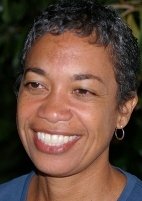 Denise Perry works for the Black Organizing for Leadership & Dignity (BOLD)project. She has been organzing for nearly 30 years.
Denise Perry works for the Black Organizing for Leadership & Dignity (BOLD)project. She has been organzing for nearly 30 years.
When I was the director of an organization that worked with Black and Latino youth in Miami, I noticed that music helped create a form of communication that fostered both a strong cultural and organizational identity. The youth members used it to entertain and to raise money with talent shows, but they were moved to a deeper interest in their organizing work when the hip-hop duo Rebel Diaz came to talk with them about the power and meaning inherent in their music.,
Our organization always used live music to help connect us with the community and to project our values through a culture-rich identity. One staff member described what we were doing as “edutainment,” the opportunity to deliver a message in music that feeds both the mind and soul.
 Ronald White is the founder and principle consultant to Building Utopia Consulting LLC. He is currently the interim executive director of Southern Partners fund.
Ronald White is the founder and principle consultant to Building Utopia Consulting LLC. He is currently the interim executive director of Southern Partners fund.
Because structural racism is mostly hidden, philanthropic support for community organizing efforts that explicitly names and fights the problem has been rare. There are some important exceptions, however, as revealed by the following conversation with several key funders. Among the voices in this article are leaders of foundations operating within a spectrum of work contributing to racial justice and community engagement. Here, they discuss challenges they continue to face, offer lessons recently learned, and share wisdom taught by some of their grantees.
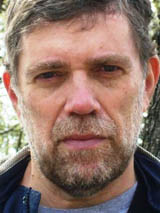 Rick Cohen is the national correspondent of the Nonprofit Quarterly magazine, (NPQ).
Rick Cohen is the national correspondent of the Nonprofit Quarterly magazine, (NPQ).
Among the thousands of possible subjects in the Foundation Center’s online database of some 2.4 million grants from over 100,000 private foundation, corporate and public charity grantmakers, the terms “community organizing” and “civic engagement” do not appear as subjects or topics around which grants are organized and counted. In light of the litany of foundation-supported and published reports attesting to the importance of community organizing in social change strategies, the absence of “community organizing” and “civic engagement” as official categories used by the Foundation Center is striking.
Critical Issues Forum, Vol. 3, Marking Progress: Movement Toward Racial Justice is the third volume of a series aiming to deepen the discourse around important progressive racial justice issues within philanthropy. In this journal nine authors tackle the problems and prospects of evaluating racial justice work, raising some of the key issues they feel the field and its funders need to consider and explore further in order to understand the true impact of our work.

Making Progress: Movement Towards Racial Justice, is the third volume of the Critical Issues Forum series, which aims to deepen the discourse around important progressive racial justice issues within philanthropy. In this journal nine authors tackle the problems and prospects of evaluating racial justice work, raising some of the key issues they feel the field and its funders need to consider and explore further in order to understand the true impact of our work.
In August of 2009 PRE embarked on a year-long project to spark discussion that could build on best practices within evaluation and how those should be applied to efforts aimed at reducing structural racism. The effort began with discussion and debate with some key advocates, activists and evaluators working on these issues at national and local levels, and was followed by similar discussions of funders, and then among additional local activists.
This publication shares the views of several of these thought leaders, as they synthesize the ways evaluation can be most effective when measuring the progress being made towards achieving racial justice.
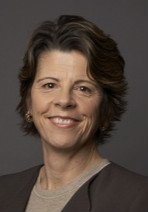 Quinn Delaney is founder and President of Akonadi Foundation, an Oakland, California based foundation working to support and nurture a racial justice movement to put an end to the structural racism that lies at the heart of social inequity in the United States.
Quinn Delaney is founder and President of Akonadi Foundation, an Oakland, California based foundation working to support and nurture a racial justice movement to put an end to the structural racism that lies at the heart of social inequity in the United States.
Working in the area of racial justice requires us to ask big questions: How do we transform our society and our institutions? How do we address interlocking systems of racial inequities? How do we simultaneously address institutional racism and interpersonal/internal racism? How does transformational change occur?
Lori Villarosa is the executive director and founder of the Philanthropic Initiative for Racial Equity (PRE), a multiyear project intended to increase the amount and effectiveness of resources aimed at combating institutional and structural racism. Lori has worked in philanthropy for more than 18 years; prior to launching PRE in 2003, she was a program officer with the C. S. Mott Foundation, where she developed and managed its portfolio on race relations and institutional racism within the U.S.
So much has been presented in foundation circles on project evaluation, it is difficult to imagine what more needs to be said. Evaluation approaches aimed at measuring social impacts have evolved in many progressive ways in the past decade or more, with significant work on participatory evaluation, cultural competency, efforts to measure advocacy and related social justice work or communications strategies. But it seems that of the hundreds of tools and reports on evaluation approaches – even those directly aimed at many of the components of their work such as advocacy or communications – many have not resonated with or even reached racial justice practitioners and advocates. Full Text
Maya Wiley is the Executive Director of the Center for Social Inclusion, a policy and advocacy organization which works to transform structural inequity and exclusion into structural inclusion. A civil rights attorney and policy advocate since 1989, Ms. Wiley has worked for the ACLU, NAACP Legal Defense Fund and the Open Society Institute. She has contributed to Growing Smarter: Achieving Livable Communities, Environmental Justice and Regional Equity, R. Bullard, ed. The MIT Press (2007).
What does it mean to measure the transformation of race? Funders and grantees are increasingly asked to predetermine measurable impacts and quantify them. We are asked to develop strategies, relationships, and outcomes in a linear equation. We assume, we do and we report. But the structural racism lens, a form of racialized “systems thinking,” draws us to multidimensional, complex institutional and social relationships, policies, and practices. It’s more of a constellation than an equation. It’s the stars, not algebra.
 Professor john powell is the executive director of the Kirwan Institute for the Study of Race and Ethnicity at the Ohio State University and Williams Chair in Civil Rights & Civil Liberties at the Moritz College of Law. An internationally recognized authority in the areas of civil rights, civil liberties and issues relating to race, ethnicity, poverty, and the law, he was previously national legal director of the American Civil Liberties Union, founder and director of the Institute on Race and Poverty at the University of Minnesota, and a cofounder of the Poverty & Race Research Action Council. He is a member of the PRE Advisory Board.
Professor john powell is the executive director of the Kirwan Institute for the Study of Race and Ethnicity at the Ohio State University and Williams Chair in Civil Rights & Civil Liberties at the Moritz College of Law. An internationally recognized authority in the areas of civil rights, civil liberties and issues relating to race, ethnicity, poverty, and the law, he was previously national legal director of the American Civil Liberties Union, founder and director of the Institute on Race and Poverty at the University of Minnesota, and a cofounder of the Poverty & Race Research Action Council. He is a member of the PRE Advisory Board.
As racial justice advocates and theorists, we need an evaluation approach that acknowledges what we know from a history of inadequate or failed policy interventions. We know that what works on a micro level may not be able to be scaled up; what appears promising in the short term may have no impact in the long term, what helps in the short term may in fact harm in the long term, and even policies that are far removed from the traditional concerns of racial justice advocates can either ameliorate or exacerbate racial disparities.
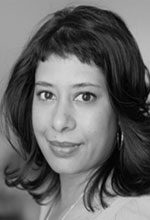 Rinku Sen, President and Executive Director of the Applied Research Center (ARC) and Publisher of ColorLines Magazine is a leading figure in the racial justice movement. Rinku has written extensively about immigration, community organizing and women’s lives for a wide variety of publications including The Huffington Post, Jack and Jill Politics, The San Francisco Chronicle, and Forbes.com. Her latest book, The Accidental American: Immigration and Citizenship in the Age of Globalization (Berrett-Koehler) won the Nautilus Book Award Silver Medal.
Rinku Sen, President and Executive Director of the Applied Research Center (ARC) and Publisher of ColorLines Magazine is a leading figure in the racial justice movement. Rinku has written extensively about immigration, community organizing and women’s lives for a wide variety of publications including The Huffington Post, Jack and Jill Politics, The San Francisco Chronicle, and Forbes.com. Her latest book, The Accidental American: Immigration and Citizenship in the Age of Globalization (Berrett-Koehler) won the Nautilus Book Award Silver Medal.
Racial equity requires the transformation of all aspects of our society, from popular thinking to legislation. Yet realpolitik involves transactions – interim steps – that take us only partly there. One way to assess whether these steps are taking us in the right direction is to constantly measure them against transformational goals. By examining the impact of such transactional advances on public discourse, constituency building and the implementation of policies, advocates can have a better sense of whether their work is moving communities toward meaningful racial justice.
 PRE: What do you think are meaningful indicators for measuring progress in addressing structural racism?
PRE: What do you think are meaningful indicators for measuring progress in addressing structural racism?
KK: I think there are some new tools that cities, governments and organizations are pushing to help us get there – racial equity impact statements, racial equity report cards. There are ways of evaluating the end impact of policy through the racial disparity lens and ensuring that you have race-neutral outcomes at the forefront of policy rather than 20 years down the line. Some of those tools have gained traction in ways that are significant.
 Cathi Tactaquin, executive director of the Oakland, California-based National Network for Immigrant and Refugee Rights
PRE: How do you incorporate a structural racism analysis into your work?
We try to connect our work to a deeper and broader analysis of structural racism, and in the education work and training that we do, we try to utilize a racial lens throughout that work. What we hope will be an outcome of that investment is an awareness of structural racism for our main constituency of immigrant organizations and that people will begin to apply that in their organizing, analysis work and their own educational work. We recognize that addressing structural racism includes concerns of immigrant communities; they’re not two separate issues
Full Text
Cathi Tactaquin, executive director of the Oakland, California-based National Network for Immigrant and Refugee Rights
PRE: How do you incorporate a structural racism analysis into your work?
We try to connect our work to a deeper and broader analysis of structural racism, and in the education work and training that we do, we try to utilize a racial lens throughout that work. What we hope will be an outcome of that investment is an awareness of structural racism for our main constituency of immigrant organizations and that people will begin to apply that in their organizing, analysis work and their own educational work. We recognize that addressing structural racism includes concerns of immigrant communities; they’re not two separate issues
Full Text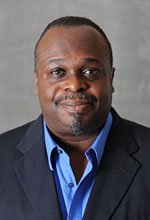 PRE: How are you able to measure and assess whether your work is having an impact, especially in view of the many barriers our communities face?
PRE: How are you able to measure and assess whether your work is having an impact, especially in view of the many barriers our communities face?
BJ: First of all, I think these are long-range strategies. What’s needed in the long term includes questions such as: Has there been a change in the public discourse and debate? Is the issue of targeted resourcing being discussed more in the media? Are people taking up those issues? Are policy demands being brought forth on a local level that impact the community in a positive way?
 Soya Jung is a consultant for non profits and public interest projects, providing project management and organizational development services to local and national organizations. From 2001 to 2006 she was the Grants and Program Director for the Social Justice Fund NW, and played a key role in institutionalizing the foundation’s commitment to racial equity. Her field experience is in immigrant rights and grassroots journalism.
Soya Jung is a consultant for non profits and public interest projects, providing project management and organizational development services to local and national organizations. From 2001 to 2006 she was the Grants and Program Director for the Social Justice Fund NW, and played a key role in institutionalizing the foundation’s commitment to racial equity. Her field experience is in immigrant rights and grassroots journalism.
Conversations with several foundation program officers whose institutions are designing racial justice evaluation methods show significant challenges in developing these methods, but also reveal commitment and potential for moving forward. Through these discussions, three critical components in evaluating racial justice efforts surfaced: shared racial justice language and definitions, a clear theory of change based on movementbuilding principles and a way to capture and disseminate the stories of racial justice.
 Sally Leiderman is President of the non-profit Center for Assessment and Policy Development. She is an experienced evaluator of efforts aimed at reducing institutional racism, supporting racial equity or building more inclusive communities, including Project Change; the Bridging Initiative of the National Capitol Region; Communities Creating Racial Equity; Communities for All Ages; the Americans for Indian Opportunity Ambassadors Program and others. Ms. Leiderman co-created www.racialequitytools.org and www.evaluationtoolsforracialequity.org.
Sally Leiderman is President of the non-profit Center for Assessment and Policy Development. She is an experienced evaluator of efforts aimed at reducing institutional racism, supporting racial equity or building more inclusive communities, including Project Change; the Bridging Initiative of the National Capitol Region; Communities Creating Racial Equity; Communities for All Ages; the Americans for Indian Opportunity Ambassadors Program and others. Ms. Leiderman co-created www.racialequitytools.org and www.evaluationtoolsforracialequity.org.
People engaged in racial justice work face considerable pressure to provide evidence that their organization’s particular approach makes a tangible difference in people’s lives. The pressure comes from their own sense of urgency, from their constituents and from funders. Many people who fund this work are under similar pressure, sharing that sense of urgency, having to account for their decisions, and, like practitioners, wanting to structure future decisions based on evidence that the work is creating improvements. Evaluation sits right at the nexus of these similar and sometimes competing pressures.
Full Text Michelle Fine, Distinguished Professor of Social Psychology, Women’s Studies and Urban Education at the Graduate Center, CUNY has taught at CUNY since 1992 and is a founding member of the Participatory Action Research Collective. Michelle’s research has been organized through participatory action research and focuses how youth think about and contest injustice in schools, communities and prisons.
Michelle Fine, Distinguished Professor of Social Psychology, Women’s Studies and Urban Education at the Graduate Center, CUNY has taught at CUNY since 1992 and is a founding member of the Participatory Action Research Collective. Michelle’s research has been organized through participatory action research and focuses how youth think about and contest injustice in schools, communities and prisons.
Structural racism projects are bold, ambitious initiatives dedicated to documenting and transforming a thick overgrowth of policies, practices, traditions and ideologies that have justified and naturalized racialized injustices. Whether implemented in government, schools, prisons, worksites or communities, such interventions are typically resisted or contained; domesticated to “fit” into existing arrangements. In the language of Rinku Sen, executive director of the Applied Research Center, most of these projects set out to be transformational and end up transactional (see page X). Vibrant political visions too often shrink to technical solutions. This short essay advances critical participatory evaluation as an essential tool to hold institutions accountable for racial justice and research validity.
 Maggie Potapchuk is the founder of MP Associates, dedicated to building the capacity of organizations and communities to effectively address racism and privilege issues for building a just and inclusive society. She cocreated www.racialequitytools.org and www.evaluationtoolsforracialequity.org. Her research includes Community Change Processes and Progress in Addressing Racial Inequities, Flipping The Script: White Privilege and Community Building, and Cultivating Interdependence: A Guide for Race Relations and Racial Justice Organizations.
Maggie Potapchuk is the founder of MP Associates, dedicated to building the capacity of organizations and communities to effectively address racism and privilege issues for building a just and inclusive society. She cocreated www.racialequitytools.org and www.evaluationtoolsforracialequity.org. Her research includes Community Change Processes and Progress in Addressing Racial Inequities, Flipping The Script: White Privilege and Community Building, and Cultivating Interdependence: A Guide for Race Relations and Racial Justice Organizations.
We know that efforts to eradicate structural racism are consistently met with resistance, so that advances in one area (such as education) may result in backward movement in another (such as housing). In order to more effectively respond to the “repositioning of the color line rather than its erasure,” collective action that crosses issue areas and communities may be far more effective than works of disparate organizations. As a practitioner, advocate and long-time consumer of evaluation, I’ve come to believe not only in the value of communities of practice (CoP) – groups of people dedicated to shared learning and practice – for action against structural racism, but also in their potential for fostering meaningful evaluation of racial justice efforts.
This section lists a few of the many publications, journal articles and websites that address the core issues built upon in this volume, including structural racism and systems thinking, culturally competent and participatory evaluation, and/or evaluations that address issues of advocacy, social justice, diversity or equity. As noted in this volume, there are few, if any, current resources that specifically address how to evaluate racial justice efforts from a structural perspective, but many existing tools could be built upon or adapted.

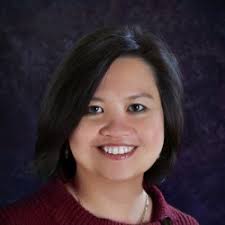
When several California foundations structured a response to the California legislature on the question of enhanced reporting regarding large foundations’ support of nonprofits serving communities of colors, the agreement downplayed the issue of mandatory public reporting in favor of strategies to better support nonprofits serving communities of color. In addition to commitments to help build a diverse pipeline of leaders for the nonprofit and philanthropic sectors and supporting ongoing research, a core component of the foundations’ plan was to build the capacities of nonprofits that serve communities of color or are led by people of color.
The foundations appear to assume that it is the nonprofits, not philanthropic grantmakers themselves that need capacity building. It also wouldn’t surprise me if the foundations assume a one-size-fits-all-capacity-building approach for all nonprofits that serve minority and low-income communities, including those that are led by people of color. They’re wrong; capacity-building for racial and ethnic equity is complicated. Nonprofits that serve minority and low-income communities do not operate in isolation. Effective capacity building of these nonprofits requires developing and redirecting the orientations and skills of a group of outside professionals who directly affect their success, including program evaluators, capacity-builders, and especially the funders themselves.
 A backroom deal in mid-2008 on assistance to minority-serving nonprofits in California followed by an end-of-the-year release of a plan of foundation assistance ostensibly to promote more grant support for racially diverse communities has closed a Pandora’s box that foundations had no desire to leave open. After vociferously opposing for almost two years proposed state legislation to increase aid to groups that serve communities of color, foundations headed off any possibility of governmental intervention in their grantmaking with a half-year process to explore what they might do to respond.
A backroom deal in mid-2008 on assistance to minority-serving nonprofits in California followed by an end-of-the-year release of a plan of foundation assistance ostensibly to promote more grant support for racially diverse communities has closed a Pandora’s box that foundations had no desire to leave open. After vociferously opposing for almost two years proposed state legislation to increase aid to groups that serve communities of color, foundations headed off any possibility of governmental intervention in their grantmaking with a half-year process to explore what they might do to respond.
 Last summer, sponsors of California Assembly Bill 624 dropped legislation that had been introduced in 2007 and passed by the Assembly in January 2008. If it had been enacted, AB624 would have required funders to report on the race of their grant recipients’ leaders. Many large foundations lined up in opposition to the bill in various public forums, and then eventually “settled” with bill cosponsors. The bill was not as thoughtful as it should have been. There was not sufficient dialogue with a wide range of stakeholders in either its inception or preceding the deal that was made.
Last summer, sponsors of California Assembly Bill 624 dropped legislation that had been introduced in 2007 and passed by the Assembly in January 2008. If it had been enacted, AB624 would have required funders to report on the race of their grant recipients’ leaders. Many large foundations lined up in opposition to the bill in various public forums, and then eventually “settled” with bill cosponsors. The bill was not as thoughtful as it should have been. There was not sufficient dialogue with a wide range of stakeholders in either its inception or preceding the deal that was made.
Foundations need to have a much more self-critical internal and more robust public dialogue about why and how they must support people of color-led organizations.
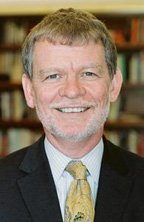 Gara LaMarche, a long-time human and civil rights advocate, is president and CEO of The Atlantic Philanthropies. Before joining Atlantic, LaMarche served as vice president and director of U.S. Programs for the Open Society Institute.
Gara LaMarche, a long-time human and civil rights advocate, is president and CEO of The Atlantic Philanthropies. Before joining Atlantic, LaMarche served as vice president and director of U.S. Programs for the Open Society Institute.
The debate inside and outside California about AB 624, the state bill that would mandate the collection and posting by foundations of data about their grantmaking to communities of color, presents a clash between well intentioned but misdirected intervention by government and defensive reactions from the philanthropic sector. The net result, whatever happens to the legislation – which seems unlikely to pass in its current form, anyway – is that mistrust between the two sectors could widen. There is danger that the debate will distract attention from the most profound issues of race and power that the bill is trying to address.
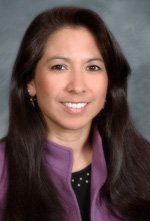 Lori Villarosa is the executive director of Philanthropic Initiative for Racial Equity. Prior to launching this initiative in 2003, she spent 11 years at the Mott Foundation, where shedeveloped its U.S. Race Relations portfolio. She serves on the board of the Winthrop Rockefeller and Paul J. Aicher Foundations.
Lori Villarosa is the executive director of Philanthropic Initiative for Racial Equity. Prior to launching this initiative in 2003, she spent 11 years at the Mott Foundation, where shedeveloped its U.S. Race Relations portfolio. She serves on the board of the Winthrop Rockefeller and Paul J. Aicher Foundations.
Like many of our colleagues who have long advocated for philanthropy to increase giving around a range of racial and social justice issues, we at the Philanthropic Initiative for Racial Equity (PRE) have been unclear as to whether a legislative battle over data collection is a fight we really want. Nonetheless, the debate is here and centered around California Assembly Bill 624 (AB 624), which calls for large California foundations to report on racial/ethnic composition of their staffing, governance and grantmaking. But regardless of the direct impact of legislation, there is now both an opportunity, and increasingly, a need, to surface critical issues about what is and isn’t valued by philanthropy – and how that is defined, determined and measured.
 Rick Cohen is the national correspondent of Nonprofit Quarterly magazine. Prior to joining NPQ, he was the executive director of the National Committee for Responsive Philanthropy, a national nonprofit philanthropic watchdog organization. He is a former member of the PRE advisory board.
Rick Cohen is the national correspondent of Nonprofit Quarterly magazine. Prior to joining NPQ, he was the executive director of the National Committee for Responsive Philanthropy, a national nonprofit philanthropic watchdog organization. He is a former member of the PRE advisory board.
If one California state legislator has his way, his state may soon compel some foundations to let the public know the extent to which their work touches people of color, gender minorities and low-income communities.
State Assemblyman Joe Coto has proposed a bill, known by its legislative number AB624, which has energized foundations to come out swinging against the notion of compulsory reporting by foundations on the diversity of their own makeup and of their grantmaking. The lessons learned from this still unfolding legislative battle might be useful in a future dialogue on the question of promoting more racial/ethnic equity in organized philanthropy.
The legislation challenges foundations to their core. Whom do foundations serve? How will philanthropy address racial and social inequities? Whether or not it passes into law, AB624, warts and all, raises important issues that foundations have often addressed through largely unproductive expressions of caring commitment to diversity
 David Cournoyer is co-chair of the board of directors of Native Americans in Philanthropy, a Council on Foundations affinity group that seeks to build bridges between foundations and Native communities. He has worked at two national private foundations as well as the American Indian College Fund, and he previously worked for a decade as a television journalist. Cournoyer is an enrolled member of the Rosebud Sioux Tribe of South Dakota.
David Cournoyer is co-chair of the board of directors of Native Americans in Philanthropy, a Council on Foundations affinity group that seeks to build bridges between foundations and Native communities. He has worked at two national private foundations as well as the American Indian College Fund, and he previously worked for a decade as a television journalist. Cournoyer is an enrolled member of the Rosebud Sioux Tribe of South Dakota.
It’s no secret that the United States is growing more racially and ethnically diverse. Don’t you remember the breathtaking pictures of literally tens of thousands of people taking to the streets about immigration reform? Did you miss the news about the growing number of states with “majority-minority” populations?
More recently, the headlines have focused on Senator Barack Obama’s courageous appeal to Americans to recognize both the progress we have made and the significant racial disparities that still exist. It was an historic call to acknowledge that we are not yet “a more perfect union” fully capitalizing on America’s rich diversity, which brings a broad array of knowledge, cultural values and perspectives.
What is philanthropy doing about this? Where’s the Obama-like, bold leadership? If the nimble nonprofit sector can’t provide aggressive support and commitment to help the U.S. capitalize on its diversity and fully promote the voice of underserved communities, where will it come from? Unfortunately, many of us in the sector who represent communities of color are not setting our expectations very high.
 Eva Paterson is the president and a founder of the Equal Justice Society, a national organization dedicated to changing the law through progressive legal theory, public policy and practice. Previously, she worked at the Lawyers’ Committee for Civil Rights for 26 years. As a cofounder and chair of the California Coalition for Civil Rights, Paterson was a leading spokesperson in statewide rights campaigns. She is a member of the PRE advisory board.
Eva Paterson is the president and a founder of the Equal Justice Society, a national organization dedicated to changing the law through progressive legal theory, public policy and practice. Previously, she worked at the Lawyers’ Committee for Civil Rights for 26 years. As a cofounder and chair of the California Coalition for Civil Rights, Paterson was a leading spokesperson in statewide rights campaigns. She is a member of the PRE advisory board.
We are currently involved in a controversy about whether or not foundations should be required to collect data on the race or ethnicity of its grantees. This topic brings to mind Black Power advocate Eldridge Cleaver’s famous admonition that you are either part of the problem or part of the solution. Philanthropy has played both roles.
When one looks at this more closely, the controversy is yet another manifestation of the dis-ease we have with dealing forthrightly with race. It would be safer to duck this issue and to lie low until it blows over, but we at the Equal Justice Society (EJS) after much anguished discussion decided we must speak.
Foundations have provided critical support in the advancement of racial justice. In 1922, Charles Garland, a 21-year old Harvard undergrad, established the Garland Fund. One of Garland’s goals was to improve the schools that Black children attended. I recently read a moving essay by Alice Walker who describes walking past White schools on her way to under-funded and dilapidated Black schools in Georgia. The brilliance of Black teachers in these segregated schools is legendary in spite of being hobbled by outdated books and few resources. Charles Hamilton Houston, Thurgood Marshall, Jack Greenberg, Constance Baker Motley and other attorneys looked for a strategy that would result in a better education for Black kids. The Garland Fund supported the development of the three-decade strategy that culminated in Brown v Board of Education. James Weldon Johnson, Roger Baldwin and Norman Thomas administered the board.
 Rinku Sen is the president and executive director of the Applied Research Center and publisher of ColorLines. Her latest book, The Accidental American: Immigration and Citizenship in the Age of Globalization (Berrett-Koehler) was released in September, 2008. She is a member of the PRE advisory board.
Rinku Sen is the president and executive director of the Applied Research Center and publisher of ColorLines. Her latest book, The Accidental American: Immigration and Citizenship in the Age of Globalization (Berrett-Koehler) was released in September, 2008. She is a member of the PRE advisory board.
The Applied Research Center (ARC) has studied philanthropy in relation to communities of color through our report, Short-Changed: Foundation Giving and Communities of Color, and through a racial equity assessment tool that we have tested with two foundations. In each case, our findings revealed that although the total philanthropic dollars going to communities of color is dismal in itself, we have to go beyond counting diversity data to ensure that such philanthropy is generating racial justice.
It is difficult to count the distribution of philanthropic dollars by race – not all foundations keep such data, and there is no public mandate requiring it. Even with having to qualify some of the data, however, Short-Changed found that although people of color make up nearly one-third of the general U.S. population, grants explicitly targeted to benefit them constituted only 7 percent of foundation giving in 2001. Grants to African American organizations in 2000 and 2001 constituted only 1.4 percent of total foundation grants, dropping from a high of 3.8 percent in 1999. The average size of grants to organizations that supported African Americans shrank by nearly 20 percent in that time. Grants to other communities of color showed similar patterns.
 Makani Themba is the former executive director of The Praxis Project, a Washington, DC-based nonprofit organization supporting community-based policy and media advocacy nationwide. She is a member of the PRE advisory board.
Makani Themba is the former executive director of The Praxis Project, a Washington, DC-based nonprofit organization supporting community-based policy and media advocacy nationwide. She is a member of the PRE advisory board.
Every organized interest has a love-hate relationship with government regulation. We want clear public monitoring and benchmarks for the other guy. For ourselves, well, we urge more measured approaches like support for self-governance, expansion of voluntary guidelines and the perennial favorite – autonomy – because after all, us good people with good intentions don’t need sticks. We are carrot folk who can be good for, er, goodness sake.
The unfortunate truth is that those interests with the most power tend to live more of a carrot life in the world of government intervention and regulation. And those with much less power live firmly under the stick. In fact, it was partially these policy inequities that catalyzed a study and then legislation that sought to connect the dots between the lack of diversity in philanthropy and the limited capacity of traditional marginalized communities (communities of color, sexual minorities and women) to affect change in their interests.
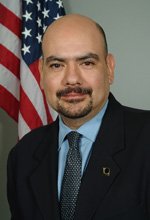 Arturo Vargas is the executive director of the NALEO Educational Fund, the leading nonprofit organization that facilitates full Latino participation in the American political process, from citizenship to public service. He is also the board chair of ZeroDivide (formerly the Community Technology Foundation) and chairs the Council on Foundations’ Committee on Inclusiveness. He is a member of the PRE advisory board.
Arturo Vargas is the executive director of the NALEO Educational Fund, the leading nonprofit organization that facilitates full Latino participation in the American political process, from citizenship to public service. He is also the board chair of ZeroDivide (formerly the Community Technology Foundation) and chairs the Council on Foundations’ Committee on Inclusiveness. He is a member of the PRE advisory board.
Funders have widely agreed that the philanthropy field and its grantmaking are not sufficiently diverse and that more resources can and should be directed to diverse communities, including communities of color. In fact, many foundation leaders point to voluntary actions as the correct alternative to legislative mandates for diversity-related data collection.
We should support the laudable actions and initiatives organized philanthropy is taking to increase its diversity. However, one of the key challenges for such voluntary efforts is how to measure progress. Absent data collection, it will be impossible to demonstrate that the field has become more diverse over time; that grantmaking is reaching more diverse communities than before, and, most important, that such increase in diversity actually is contributing to greater effectiveness.
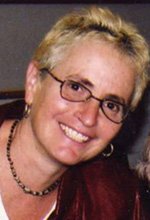 Karen Zelermyer is the executive director of Funders for Lesbian and Gay Issues. She has also served as the deputy director of the Astraea Lesbian Foundation for Justice.
Karen Zelermyer is the executive director of Funders for Lesbian and Gay Issues. She has also served as the deputy director of the Astraea Lesbian Foundation for Justice.
Every year, Funders for Lesbian and Gay Issues (FLGI) tracks how many U.S. foundations offer grants to lesbians, gay men, bisexuals, transgender and queer (LGBTQ) issues, measuring total foundations, total giving and total grants to LGBTQ organizations and projects. We gather this data by asking foundations to report who they are funding, the kind of support they are providing and for what issues and populations. We have learned that hundreds of foundations – large and small, public, community, corporate and private – collect data on their grantees as a part of their ongoing work. And while inconsistent taxonomies present numerous problems, the task does not appear to be so onerous as to prevent foundations from doing it.
FLGI is one of several identity-based affinity groups established over the past three decades to address an inequitable distribution of resources that undermines the very heart and soul of what it means to be a democratic society. These groups also challenge the underwhelming representation of people of color, LGBTQ people, people with disabilities and women in leadership positions within foundations and nonprofit organizations.
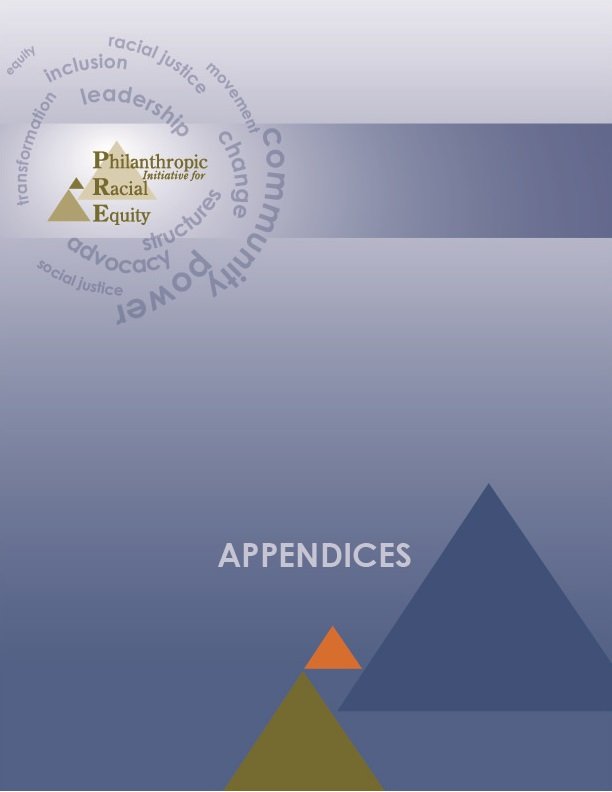
We hope that many foundations committed to strengthening their work in communities of color and LGBT communities will continue, or perhaps, start this discussion within their own institutions – away from the heated debates over legislation.
While some foundations have formal policies asking grantees to share a range of racial, ethnic and sexual orientation data, obviously many do not. Many that don’t gather such data have not made an active decision not to, but have simply never even discussed it at the board or policy level.
During a recent assessment with a foundation with an explicit commitment to addressing racial disparities, PRE found that one of the board’s strongest champions for diversity and racial equity recognized that there was no place in program staff write ups that directly addressed the racial composition of prospective grantees’ staff or board. While it often came up in discussions – because this particular foundation strongly believes in the value of stakeholders having a voice and leadership – she had not realized the data was not consistently gathered.
There are numerous reports available to provide in-depth data about various demographics, as well as additional rationale and ways to collect and use racial/ethnic data in relationship to foundation leadership and grantmaking. While not an exhaustive list, here are a few recent resources that may further inform your discussions:
What do we really know, in terms of hard research, about the greater efficacy or effectiveness of minority-led organizations serving their communities? This is the implicit question of AB624, and not answered by the generic response that “diverse” organizations are more effective or innovative entities, a contention asserted in the mathematical modeling of University of Michigan professor Scott Page1. Even if the equation of diversity yields innovation and effectiveness is correct for generic nonprofits, do the aspirations of racial/ethnic minorities-and other disenfranchised or marginalized populations-get well represented by white or “diverse” organizations, or is there something important from a perspective of empowerment and racial/ethnic equity from having people of color speak for themselves?
AB624 is hardly aimed at simply foundations’ reporting on their grantees. Provisions call for covered foundations reporting on their own top staff and board members diversity, not only by race and ethnicity, but also by gender and sexual orientation.
Can and should public policy affect the composition of foundations’ boards of trustees, for example, not to mention the executive staffing of private foundations and other philanthropic grantmakers?
The Council on Foundations’ approach to diversity of board members would probably weigh against government intervention in who gets to join foundation boards, witness this comment from a speech by COF president and CEO Steve Gunderson to the COF Family Foundations conference in 2007: “(W)e have been an overwhelmingly white, Anglo-Saxon enterprise. Family foundations, by their nature, display their diversity in the form of generations with very different views of the world-and of philanthropy. I am not here today asking you to change the make-up of your board. But I join you in recognizing the diversity of the world we serve, through your service as well.”
JOIN PRE’S MAILING LIST – If you’d like to receive updates regarding the latest PRE news, please use the form below.